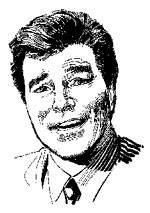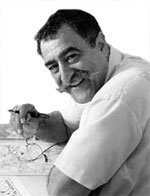>> Top Nine: Yusuf's Choice
>> Alphabetti Fumetti: S is for Shooter
More...

 A is for Adams, Neal
A is for Adams, Neal
b. 1941; New York, New York
1967: STRANGE ADVENTURES; 1968: THE BRAVE AND THE BOLD; 1969: X-MEN; 1970: DETECTIVE COMICS, GREEN LANTERN/GREEN ARROW; 1971: BATMAN, THE
AVENGERS; 1978: SUPERMAN VS MUHAMMAD ALI
Neal Adams is one of the most influential comic-book artists of his generation, with a distinctive style that is often imitated but rarely bettered. Whether it's the lithe musculature of a costumed crime-fighter, or the close-up detail of a simple hand gesture, every line and stroke contains a billion atoms of class per inch. In addition to his formidable prowess as a draughtsman, Adams has repeatedly demonstrated a strong sense of honesty and integrity - a quality that is all too rare in an industry that sometimes resembles an oversized playpen.
Before working in comics Adams trained as a commercial artist, and though his work on characters like Deadman, Batman, and the X-Men he bought a real-world sensibility and dynamic layouts that were visually challenging. Today's artists are all about gritty realism, but in the 60s and 70s the prevalent mode was a looser cartoon style where verisimilitude took a backseat to the rigours of four-colour fantasy. Adam's art showed that you could achieve both, and he stands out from his contemporaries like a Mont Blanc Pen on a tray full of ballpoints.
It is with the character of Batman that Adams is most identified, and with good reason. Thanks to a 60s worldwide smash TV show, Batman had become less "this weird avenger of the night" and more a camp crusader with an ill-fitting costume and a spare tire. Unsurprisingly, the comics began to reflect this, and when given the opportunity to work on Batman team-up book THE BRAVE AND THE BOLD, Adams took the character back to his visual roots in thirties pulp fiction.
He was drawn with pointier ears, a longer cape, and frequently given dramatic entrances from out of the shadows. Batman became more of a supernatural and imposing figure, an image that has prevailed ever since, and Adams restored what dignity remained for a man who spends his nights dressed as a flying rodent.
Adams' best work on Batman evolved through a collaboration with writer Denny O'Neil - together they revamped the Joker and created mainstay characters like Ra's Al Ghul and Man-Bat - and this relationship continued on another, equally influential series; GREEN LANTERN/GREEN ARROW. This series had a distinct social agenda, where the staid character of Hal Jordan was made "hip" by Oliver Queen to issues that couldn't easily be defined in terms of good vs evil - subjects like drugs, slum landlords, and personality cults. Whilst these stories haven't aged terribly well, they set a valuable precedent for mainstream comics that dealt with political themes.
Outside of the comics themselves, Adams was an active campaigner for creator rights. In 1974 he joined the fight to gain proper recognition for Jerry Siegel and Joe Shuster for their most famous creation, Superman, and to secure for them an annual 'pension' of $35,000 from DC comics. He also argued for artists to retain their original artwork, which soon became a lucrative avenue for many underpaid professionals. Up to that point it had been customary for companies to keep original artwork for three months and then destroy it.
Today Adams runs and owns his own business, Continuity Studios, which intermittently publishes his own comics but is mainly concerned with the production of commercial artwork. It is very profitable, and for Adams to draw a comic now would be a matter of pure nostalgia rather than a desire for artistic fulfilment or a quick fix to pay the bills. The comic book industry needs him a lot more than he needs it.
For more on Neal Adams, read the Ninth Art Thumbnail.
 A is for Aragonés, Sergio
A is for Aragonés, Sergio
b. 1931; Castellon, Spain
1963: MAD MAGAZINE; 1981: GROO THE WANDERER
Legend has it that since they first appeared in 1963, the 'Marginal Thinking' cartoons by Sergio Aragonés have appeared in every single issue of MAD except one - and that was the fault of the postman. These silent little pantomimes that stretch up the margins and snake around corners have become as integral to the magazine as the distorted features of Alfred E Neuman, and to have just one issue without them would be like eating a chocolate chip cookie minus the chocolate chips. Knowing the twisted nature of your average MAD reader (myself being one of them), that one Aragonés-free issue has probably gone on to become a collector's item.
Aragonés prides himself on being a quick-draw artist, someone who can knock out several pages in thirty seconds flat and then laugh at those foolish young upstarts who can't keep a deadline, but the one thing he should really be most proud of is the fact that he is very, very funny. Humour is notoriously tricky to describe unless you're experiencing it directly, but something in the way that Aragonés draws a face in a state of indignant outrage, or the way a dog cocks its leg as it pisses on a tree, or the bemused expression on a garbage-man's face as he rummages through a discarded porn collection, any of it is enough to cause the most sour of faces to crack a broad smile that tickles their ear-drums.
And of course, there's GROO THE WANDERER. The mighty Groo, strong of arm and weak of brain, the befuddled barbarian who flies into a rage whenever he is called a 'mendicant', even though he doesn't know what a mendicant is. Co-written with Mark Evanier, Groo was initially a satire on the sword and sorcery epics that were so popular in the early 80s, but it has outlived that trend to become one of the longest running and most successful creator-owned comics in the business. True to his name, Groo has done quite a lot of wandering - his most prolonged stint was with Marvel's Epic imprint, but he's also been published by Malibu and Image, and is currently at Dark Horse.
For all of this, and more, Aragonéés has won several major accolades, including the National Cartoonists Society's Reuben Award, and the Will Eisner Hall of Fame Award. Not bad for someone who specialises in marginal thinking.
 A is for Austen, Chuck (aka Chuck Beckum)
A is for Austen, Chuck (aka Chuck Beckum)
b. ?
1986: MIRACLEMAN; 2002: UNCANNY X-MEN
Rampaging fanboys are an occupational hazard in any field of entertainment, but some people have incurred more of their wrath than others. Chuck Austen has had the good fortune (or is that misfortune?) to work on several major comic book series, but his output as both a writer and an artist has been met with such withering scorn that you have to wonder how he ever got into the business in the first place. Even when he has changed his name, it hasn't been enough to disguise his shortcomings.
His first assignment was pencilling duties on MIRACLEMAN after the reprint material from WARRIOR magazine ran out. The difference in quality between the original art by Alan Davis and new pages by Chuck Beckum (as he was then known) was huge, though to be fair the UK material had been shrunk from its original size to fit the US format. Beckum's work was deeply unpopular with readers, perhaps because they felt it wasn't doing justice to Alan Moore's story, and after two issues he was given the boot. He also created a number of pornographic comics during the late 80s, most notably the 'semi-autobiographical' series STRIPS.
Resurfacing in the mainstream in the 00s with a new name, Austen began working as an artist on WAR MACHINE and ELEKTRA for Marvel comics. He went on to write UNCANNY X-MEN, CAPTAIN AMERICA and THE AVENGERS for the same company, and also ACTION COMICS for DC.
His writing caused a bit of a stink, however, the chief criticisms being an inability to keep people in character, a disregard for continuity, and frequent accusations of misogyny. The nascent comics blogosphere campaigned for Austen's dismissal; as their protests grew louder, Marvel felt obliged to comply, and Austen was understandably bitter about the 'trolls' who had cost him his job.
Austen has gone on to write a creator-owned comic called WORLDWATCH, described as a pornographic version of Warren Ellis' THE AUTHORITY. At the end of the second issue he announced that he had been fired and new writer Sam Clemens would be taking over - but seeing as Austen is the sole owner of WORLDWATCH and that Sam Clemens is the real name for famous American novelist Mark Twain, it would appear that Austen is once again hoping that a pseudonym will cover his ass.

This article is Ideological Freeware. The author grants permission for its reproduction and redistribution by private individuals on condition that the author and source of the article are clearly shown, no charge is made, and the whole article is reproduced intact, including this notice.


